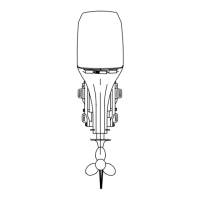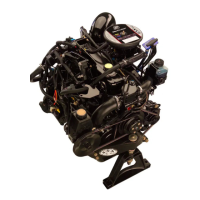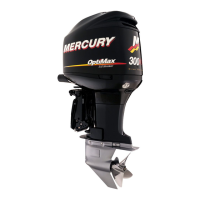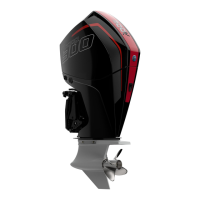3A-6 - FUEL SYSTEM 90-826148R2 MARCH 1997
Theory of Operation
Thefuelpumpisacrankcase-pressure-operated,di-
aphragm-type pump. Crankcase pulsating pressure
is transferred by way of a passage (hole) from the
crankcase to the fuel pump.
Whenthepistontravelsupward,avacuumiscreated
in the crankcase. This vacuum pulls in the fuel pump
diaphragm, the inlet check valve (in fuel pump) is
opened and, and fuel is drawn into fuel pump.
Downward motion of the piston forces out the fuel
pump diaphragm, closes the inlet check valve (to
keep fuel from returning to fuel tank) and opens the
outlet check valve, forcing fuel to the carburetors.
Troubleshooting
WARNING
FIRE AND EXPLOSION HAZARD. Observe fire
prevention rules, particularly NO SMOKING. Be-
foreservicinganypartofthefuelsystem,discon-
nect electrical system at the battery. Drain the
fuel system completely. Use an approved con-
tainer to collect and store fuel. Wipe up any spil-
lage immediately. Materials used to contain spil-
lage must be disposed of in an approved
receptacle. Any fuel system service must beper-
formed in a well ventilated area.
FUEL LEAKAGE FROM ANY PART OF THE FUEL
SYSTEM CAN BE A FIRE AND EXPLOSION HAZ-
ARD WHICH CAN CAUSE SERIOUS BODILY IN-
JURY OR DEATH. Careful periodic inspection of
the entire fuel system is mandatory, particularly
after engine storage. All fuel components, in-
cluding fuel tanks, whether plastic, metal, or fi-
berglass, fuel lines, primer bulbs, fittings, swell-
ing, and must be inspected for corrosion. Any
sign of leakage or deterioration necessitates re-
placement before further engine operation.
Checking For Restricted Fuel Flow
Caused By Anti-siphon Valves
While anti-siphon valves are helpful from a safety
stand-point,theyclog,theymaybe too small,or they
mayhavetooheavy aspring.Thepressuredropthat
occurs with these valves can create operational
problems and/or powerhead damage by restricting
flow of fuel. Some symptoms ofrestricted (lean)fuel
flow, are:
¯ Loss of fuel pump pressure
¯ Loss of power
¯ High speed surging
¯ Preignition/detonation (piston dome erosion)
¯ Outboard hesitates upon acceleration
¯ Outboard runs rough
¯ Outboard quits and cannot be restarted
¯ Outboard will not start
¯ Vapor lock
Any type of anti-siphon device must be located be-
tween the outboard fuel inlet and fuel tank outlet. A
method of checking [if such a device (or bad fuel) is
a problem source] is to operate the outboard with a
separate fuel supply which is known to be good.
If it is found that the anti-siphon valve is the causeof
the problem, either 1) replace the anti-siphon valve,
or 2) replace it with a solenoid-operated fuel shutoff
valve.

